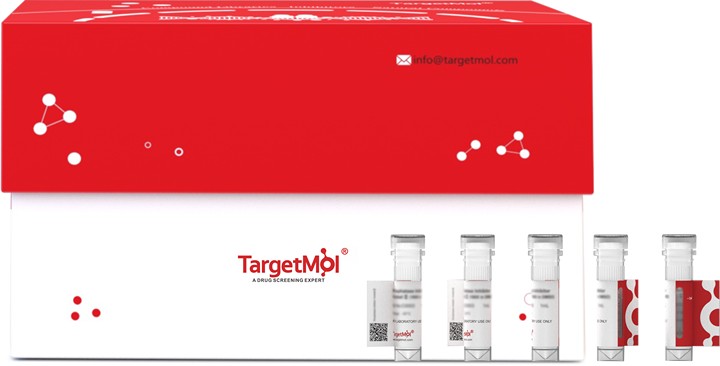 您的购物车当前为空
您的购物车当前为空
TGF beta 3 Protein, Human/Mouse/Rat, Recombinant
一键复制产品信息产品编号 TMPJ-00254
Transforming growth factor beta 3(TGFB3) is a member of a TGF -β superfamily which is defined by theirstructural and functional similarities. TGFB3 is secreted as a complex with LAP. This latent form of TGFB3becomes active upon cleavage by plasmin, matrix metalloproteases, thrombospondin -1, and a subset ofintegrins. It binds with high affinity to TGF- β RII, a type II serine/threonine kinase receptor. TGFB3 is involved incell differentiation, embryogenesis and development.It is believed to regulate molecules involved in cellularadhesion and extracellular matrix (ECM) formation during the process of palate development. Without TGF-β3,mammals develop a deformity known as a cleft palate.

TGF beta 3 Protein, Human/Mouse/Rat, Recombinant
一键复制产品信息产品编号 TMPJ-00254
Transforming growth factor beta 3(TGFB3) is a member of a TGF -β superfamily which is defined by theirstructural and functional similarities. TGFB3 is secreted as a complex with LAP. This latent form of TGFB3becomes active upon cleavage by plasmin, matrix metalloproteases, thrombospondin -1, and a subset ofintegrins. It binds with high affinity to TGF- β RII, a type II serine/threonine kinase receptor. TGFB3 is involved incell differentiation, embryogenesis and development.It is believed to regulate molecules involved in cellularadhesion and extracellular matrix (ECM) formation during the process of palate development. Without TGF-β3,mammals develop a deformity known as a cleft palate.
| 规格 | 价格 | 库存 | 数量 |
|---|---|---|---|
| 5 μg | ¥ 693 | 3日内发货 | |
| 10 μg | ¥ 1,170 | 现货 | |
| 20 μg | ¥ 1,860 | 5日内发货 | |
| 50 μg | ¥ 3,470 | 5日内发货 | |
| 100 μg | ¥ 5,380 | 5日内发货 | |
| 200 μg | ¥ 8,360 | 5日内发货 | |
| 500 μg | ¥ 15,000 | 5日内发货 | |
| 1 mg | ¥ 24,100 | 5日内发货 |
大包装 & 定制
加入购物车
TargetMol 的所有产品仅用作科学研究或药证申报,不能被用于人体,我们不向个人提供产品和服务。请您遵守承诺用途,不得违反法律法规规定用于任何其他用途。
产品信息
| 生物活性 | Measured by its ability to inhibit the IL-4-dependent proliferation of TF-1 mouse T cells. The ED50 for this effect is 10-80 pg/ml. (QC verified)  |
| 产品描述 | Transforming growth factor beta 3(TGFB3) is a member of a TGF -β superfamily which is defined by theirstructural and functional similarities. TGFB3 is secreted as a complex with LAP. This latent form of TGFB3becomes active upon cleavage by plasmin, matrix metalloproteases, thrombospondin -1, and a subset ofintegrins. It binds with high affinity to TGF- β RII, a type II serine/threonine kinase receptor. TGFB3 is involved incell differentiation, embryogenesis and development.It is believed to regulate molecules involved in cellularadhesion and extracellular matrix (ECM) formation during the process of palate development. Without TGF-β3,mammals develop a deformity known as a cleft palate. |
| 种属 | Human,Mouse,Rat |
| 表达系统 | HEK293 Cells |
| 标签 | Tag Free |
| 蛋白编号 | P10600 |
| 别名 | Transforming growth factor β-3,Transforming growth factor beta-3,TGF-β-3,TGF-beta-3,TGFB3,Latency-associated peptide,LAP |
| 氨基酸序列 | Ala301-Ser412(Tyr340Phe) |
| 蛋白构建 | Ala301-Ser412(Tyr340Phe) |
| 蛋白纯度 | Greater than 95% as determined by reducing SDS-PAGE. (QC verified)  |
| 分子量 | 12-14 KDa (reducing condition) |
| 内毒素 | < 0.001 ng/µg (0.01 EU/µg) as determined by LAL test. |
| 缓冲液 | Lyophilized from a solution filtered through a 0.22 μm filter, containing 50 mM Glycine-HCl, 150 mM NaCl, pH 2.5. |
| 复溶方法 | Reconstitute the lyophilized protein in distilled water. The product concentration should not be less than 100 μg/ml. Before opening, centrifuge the tube to collect powder at the bottom. After adding the reconstitution buffer, avoid vortexing or pipetting for mixing. |
| 存储 | Lyophilized powders can be stably stored for over 12 months, while liquid products can be stored for 6-12 months at -80°C. For reconstituted protein solutions, the solution can be stored at -20°C to -80°C for at least 3 months. Please avoid multiple freeze-thaw cycles and store products in aliquots. |
| 运输方式 | In general, Lyophilized powders are shipping with blue ice. Solutions are shipping with dry ice. |
| 研究背景 | Transforming growth factor beta 3(TGFB3) is a member of a TGF -β superfamily which is defined by theirstructural and functional similarities. TGFB3 is secreted as a complex with LAP. This latent form of TGFB3becomes active upon cleavage by plasmin, matrix metalloproteases, thrombospondin -1, and a subset ofintegrins. It binds with high affinity to TGF- β RII, a type II serine/threonine kinase receptor. TGFB3 is involved incell differentiation, embryogenesis and development.It is believed to regulate molecules involved in cellularadhesion and extracellular matrix (ECM) formation during the process of palate development. Without TGF-β3,mammals develop a deformity known as a cleft palate. |
引用文献
技术支持
请阅读 重组蛋白用户指南 了解更多具体信息.





 |
|